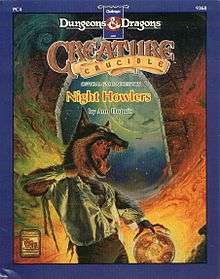Night Howlers
 | |
| Genre | Role-playing games |
|---|---|
| Publisher | TSR |
Publication date | 1992 |
Night Howlers is an accessory for the Dungeons & Dragons fantasy role-playing game, published in 1992.
Contents
Players will require a copy of the D&D game Rules Cyclopedia to use this book.[1] The D&D game presents lycanthropes as disease victims rather than members of a unique race. Any human player character can become a werecreature. Players using lycanthropic PCs must keep two sets of statistics, one for the human form, another for the beast, using the Werecreature Character Record Sheet, a single-page form that comes with the package.[1] The "Werewolves' Manual" provides detailed descriptions of the D&D game's ten standard were-types, outlining their restrictions and special abilities. Available types include the weretiger, wererat, wereseal, weresharks, and devil swine, and most special abilities are received as level advancement bonuses.[1] The D&D rules require lycanthropy victims to assume the alignment of their beast-form, which is usually Chaotic, but Night Howlers allows a PC lycanthrope to make a saving throw when transforming; a successful throw enables a bestial PC to retain the alignment of his human form.[1] The book also includes role-playing tips to address the aspects of a werecreature's split personality.[1]
Normally, an infected PC automatically transforms during the full moon, but Night Howlers enables him to resist the change with a successful saving throw; conversely, he may transform voluntarily by making a Constitution check, modified by the phase of the moon, and at higher levels a lycanthrope can change into an intermediate "beast-man," combining the special abilities of both his animal and human forms.[1] The combat section clarifies the effects of damage—an injury suffered by the active form can affect the inactive form as well—and suggests penalties for lycanthropes who don't get enough rest.[1] "Lycanthropic Procedures" handles some of the difficult aspects of shapeshifting, such as whether a lycanthrope can transform while wearing armor, or if a lycanthrope can ride a horse.[1]
The "DM's Guide" covers the basics of converting existing characters to werecreatures, setting the tone of the game, and adapting published scenarios. A table compares the relative levels of human and werecreature characters, for help with designing balanced encounters.[1] The "Valley of Wolves" chapter presents a setting that ties neatly into The Principalities of Glantri D&D Gazetteer.[1] Scenario outlines are included, such as: "A-Hunting We Will Go", which illustrates the problems facing werecreatures on hunting expeditions, while "The White Wolf of Morlay" challenges the PCs to rescue a white wolf from Dame Genevieve, a magic researcher who uses lycanthropes for lab rats.[1]
Publication history
Night Howlers was published by TSR, Inc. as a 32-page "Werewolves' Manual", a 64-page "DM's Guide", and a 32"X21" color map sheet.[1] Design was by Ann Dupuis and editing by Jonatha Ariadne Caspian, with a cover by Fred Fields and illustrations by James Crabtree.[1]
Reception
Rick Swan reviewed Night Howlers for Dragon magazine #192 (April 1993).[1] He says that Night Howlers "achieves its modest goals quite successfully, providing slick, straightforward guidelines for incorporating lycanthropic PCs into Dungeons & Dragons campaigns".[1] He cautions that players will require "a high tolerance for the system's eccentricities", since D&D lycanthropes can't be harmed by ordinary weapons, and include "oddball variants".[1] He notes that while keeping track of two sets of character statistics "sounds like a chore", but the Werecreature Character Record Sheet "makes it snap".[1] He felt that acquiring special abilities through level advancement was "a nice touch that encourages players to stick with their lycanthropic PCs though a campaign".[1] He considers Chaotic "the most difficult alignment to play effectively" but calls the saving throw when transforming to retain the alignment of the human form "a good rule, strongly recommended".[1] Swan felt that the role-playing tips "address only the most obvious aspects of a werecreature's split personality", commenting that Dupuis "seems more interested in physiology than psychology, making the book less useful than it could've been".[1] He felt that the strongest material in Night Howlers deals with staging adventures, and called the scenario outlines "Best of all" because they are "designed to take optimum advantage of lycanthropic characters".[1] Swan felt that Night Howlers "lacks the atmosphere and spectacle of the Werewolf game", which he also reviewed in the same column, and concluded his review by saying: "but it delivers the goods to D&D game players who want to shake up their campaigns. Unlike Werewolf, Night Howlers accommodates a wide range of playing styles, from high fantasy to low comedy (humor is about as welcome in Werewolf as a whoopee cushion at a funeral). The clear, direct writing and clutter-free presentation enables DMs to incorporate lycanthropic characters with a minimum of fuss. I suggest going easy at first—the powerful shapeshifting PCs tend to give their uninfected companions inferiority complexes—but used judiciously, Night Howlers can produce some of the wildest D&D sessions you've ever experienced."[1]
Reviews
- White Wolf #35